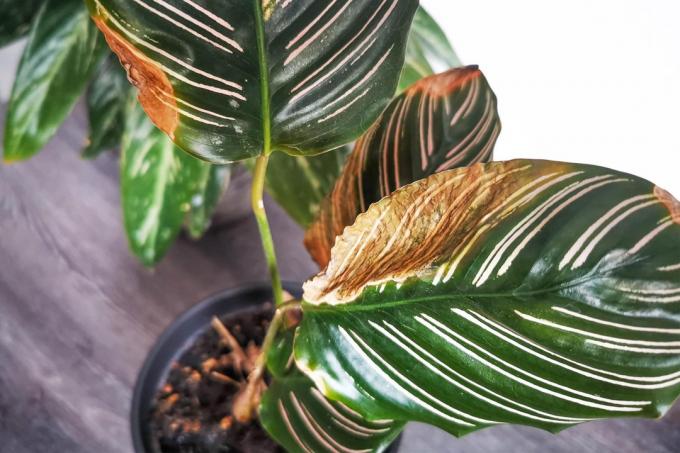

Table of contents
- Characteristics
- Location
- Plant
- watering and fertilizing
- propagation
- cutting and overwintering
- risk of confusion
- diseases and pests
- Worth knowing about the blue leadwort shortly
Of all plumbago species, Ceratostigma plumbaginoides is the most commonly cultivated in our gardens. The perennial makes an excellent groundcover and adapts to many different living conditions. Due to its lateral foothills, the blue leadwort spreads rather slowly. It forms wonderful cushions in groups, but never becomes a nuisance or even proliferates. This makes it the ideal plant for perennial beds, woody edges or even rock gardens. The leadwort reacts sensitively to moisture in winter, otherwise it is rather easy to care for.
Characteristics
- botanical name: Ceratostigma plumbaginoides
- other names: Chinese leadwort, creeping hornscar, gentian leadwort
- belongs to the leadwort family (Plumbaginaceae)
- deciduous herbaceous perennial, ground cover
- Height of growth: 20-30 cm, carpet-like
- Leaves: lanceolate stalks, red autumn colour
- Flowers: sky-blue, peduncle-shaped (wheel-shaped) flowers from August to October
- perennial
- hardy
Location
Seven of the eight leadwort species come from Asia, only one species occurs in East Africa. Blue leadwort grows in western China on both forest floors and forest edges, but is also found in open spaces. In the garden, it prefers a sunny to semi-shady location and gets along with almost all normal garden soils that are well drained. All locations that receive at least four hours of sunshine are favourable. It does well in shady areas, but blooms a little less. The blue leadwort can be used in many ways in the garden. It tolerates living areas on the edges of trees or under sparse trees, gravel areas, stone beds and steppe gardens and even grows on the top of walls or in dry walls without any problems. In addition, leadwort is also suitable for greening dry slopes, as it protects the soil from erosion.
- Light requirements: sunny to semi-shady
- normal garden soil, permeable to water
- slightly humus, also like stony or rocky
- sandy loamy
- neutral to chalky (7-9)
- dry to slightly fresh (moist) soil
- Warmth-loving, resistant to heat
Tip:
Beautiful companion for roses, spurge (Euphorbia), cinquefoil (Potentilla), summer daisies (Leucanthemum maximum), Japanese sedge (Carex morrowii) and Zieste (Stachys).
Plant
The blue leadwort does well in combination with spring flowering bulbs that are colored to match the blue flower (yellow, orange). The ground cover is also well suited for beds in which tall grass forms the background. Small perennials that bloom early in spring are not a problem as neighbors, since the blue leadwort does not sprout its leaves until very late (May). However, all other low-growing plants will be overgrown by the competitive plant over time and will die due to lack of space and light. A Chinese leadwort is very easy to care for and adaptable, but sand and grit should still be worked into heavy soil before planting so that waterlogging never occurs.
- Time: spring from April/May
- Planting distance: 25-30 cm
- plant in larger groups (at least 5)
- impressive in colonies of 20-50 individual plants
- about 8 to 15 plants per square meter
- the drier and rockier the soil, the more plants are needed for the area
A leadwort is also very decorative in flower pots on the terrace or balcony. It is well suited for a combination with onion bloomers such as tulips or daffodils, as it only sprout when the early bloomers have already withered.
Tip:
Young plants are somewhat sensitive to late spring frosts, so replanting is not recommended until May.
watering and fertilizing
The gentian leadwurz is a drought-tolerant ground cover that hardly ever needs additional watering in humus-rich, moist areas at the edge of the forest. On very sandy or stony subsoil, regular watering is necessary if the summer is very hot or there is a long drought. However, leadwort should never be watered in full sunlight (midday). Early morning hours or late evening are more suitable. The perennials do not tolerate waterlogging, so the soil should be well drained so that rainwater or irrigation water can always run off well. Fertilizing with compost, horn shavings or horn meal is recommended in spring. These natural long-term fertilizers then supply the plants with all the necessary nutrients throughout the year.
Tip:
Don't worry if there are still no new shoots on the blue leadwort in May. The plant sprouts very late, sometimes as late as June!
propagation
Leadwort reproduces both via seeds and underground runners that develop laterally on the main plant. These runners can easily be cut off with a sharp knife in autumn when some roots have already formed. Then you just put them back in the ground somewhere else and water them well. With healthy, older plants, propagation by cuttings is another method of propagating the plant vegetatively.
- Time: spring to summer
- cut head cuttings (without flowers) after they have been expelled
- (head cuttings are shoot tips covered with several leaves)
- Length: 5-15cm
- remove lower leaves
- leave about 3-5 leaves
- scrape off the upper layer at the bottom of the stem with a sharp knife (2 cm)
- use in moist potting soil or cactus soil
- Cover with plastic wrap
- set up brightly (without direct sun).
After rooting - recognizable by the first new shoot tips - the plastic bag is removed and the plant is watered normally. In late summer (or next spring) the leadwort can then go outdoors. If you spend the winter indoors: keep in a cool and bright place.
cutting and overwintering
During the year the Chinese leadwort is not cut. In principle, the shoots can be cut off close to the ground in autumn, as they will not survive the winter anyway. However, it is better to leave the foliage over the winter and only cut back in early spring. This has two advantages: on the one hand, the beautiful deep red autumn foliage adorns it for a long time Garden, secondly, the foliage (even if wilted or rotten) serves as a natural winter protection frosts. Ceratostigma plumbaginoides are frost hardy down to temperatures of -23 °C. The gentian leadwort (like other perennials) should never be cut back too early, as the plant still has to store reserves for the winter in the tubers or roots. Earliest time to cut: When foliage begins to slowly rot or dry up. Before the leadwort sprouts again, it can simply be cut off about 3 cm above ground level.
Tip:
If you cut back the shoots in autumn, you should protect the roots from frost with some leaves or brushwood.
risk of confusion
Ceratostigma plumbaginoides is easily confused with Plumbago auriculata and Plumbago indica – both leadwort species that do not tolerate frost and therefore do not spend the winter outdoors may.
diseases and pests
Chinese leadwort is a hardy perennial. Problems with pests or diseases are very rare. In the cold, damp spring months, the snail-resistant plant can sometimes become infested with powdery mildew. In these cases, infected plant parts must be removed promptly and disposed of with household waste.
Worth knowing about the blue leadwort shortly
- Anyone who wants to bring a touch of Asia into their own garden is well served with the robust and easy-care perennial.
- The blue leadwort is one of the loveliest ground cover plants in partially shaded border beds or in the rock garden.
- For woody perennials, it produces rare blue flowers from August, which form a stark contrast to its red fall foliage from autumn onwards.
Tip:
The leadwort Ceratostigma plumbaginoides is often confused with the leadwort, which grows as a climbing plant. But the one described here is one ground cover, who does not come from Africa but from Asia.
- The location for the Chinese leadwort should be in full sun to partial shade. He likes a warm place.
- Since the twigs break easily, a wind-protected place is recommended.
- The soil should be moderately dry, slightly chalky, lean and well-drained.
- If the soil is heavy, you can mix in some sand to avoid waterlogging. Leadwort also likes mineral soils.
- Watering is done regularly during the warm seasons, but not too much. Leadwort is drought tolerant.
- Waterlogging is not tolerated, nor is winter wetness.
- In the spring, before sprouting, the leadwort should be cut off about 3 cm above the ground.
- Dried leaves should be removed as they encourage the growth of fungi.
- In winter, the leadwort needs winter protection, especially in rough locations. Rice is suitable for this.
- Leadwort is propagated by seed or cuttings. But it also spreads quickly through foothills and can really proliferate.
- Leadwort, which grows as a climbing plant, likes a lot of sun, as the plant comes from southern Africa. A sheltered spot is ideal.
- In summer the plant needs sufficient water. However, waterlogging must be avoided at all costs.
- Weekly fertilizer application is recommended from April to September.
Tip:
Leadwort grows very quickly. It is important that the tips are always trimmed, that it not only grows in length, but also branches out. The faded, sticky calyxes should be removed regularly. It is good if you give the leadwort a climbing frame or trellis, as otherwise the growth habit can sometimes take on very strange forms.
- The leadwort is not hardy, but can be used as a container plant be overwintered indoors.
- Before clearing, all branches should be cut back to a third or even half. This delays flowering a bit.
- Leadwort overwinters best in a bright room at temperatures between 8 and 12 ºC.
- However, it is also possible to place them in a relatively dark room, at temperatures between 5 and 8ºC. However, the plant loses its leaves.
- Only a little is poured, just enough so that the bale does not dry out.
- At the bright wintering the leadwort only has to be thinned out in the spring.
 garden editorial
garden editorial I write about everything that interests me in my garden.
Learn more about houseplants

16 cat-friendly houseplants
If you share an apartment with a cat, you should not have any poisonous indoor plants, because cats occasionally eat the greenery. There are many cat-friendly houseplants that are harmless and can recover quickly once a cat has bitten them.

Calathea gets brown leaves: how to save?
The foliage of a calathea, also known as a basket marante, has its price. And that doesn't mean the purchase price. The tropical plant wants to be cared for and feels like it is in its native rainforest. She expresses her dissatisfaction with unfavorable living conditions with brown leaves.

Monstera droops leaves: what to do?
Its serrated leaves make the Monstera one of the most popular indoor plants. But what can be the reason for it letting the leaves droop, and what can you do about it?

Water houseplants properly 15 tips for potted plants
Watering indoor plants properly sometimes turns out to be more difficult than expected. There are certain points you need to keep in mind when watering your indoor plants so they can show off their full glory. 15 tips on the subject can be found in this guide.

Efeutute, Epipremnum aureum: care from A - Z
The ivy or Epipremnum aureum is one of the most popular houseplants par excellence and is also ideal for people without a green thumb. You can find out how to care for the plant from A - Z here.

Christmas Cactus Losing Buds: 6 Reasons & Solutions
The Christmas cactus is a real feast for the eyes in the living room from late summer with its beautiful flowers. Unfortunately, it often happens that the houseplant loses its buds. Find out here what causes the buds to fall and how you can counteract them.



